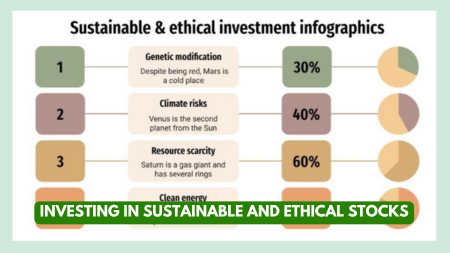No products in the cart.
Stock Market, Stock Market
Stocks: Investing that is Sustainable and Ethical 2025
Investing in Sustainable and Ethical Stocks
A comprehensive understanding of a company’s financial health is crucial before making any investment decisions. One of the most effective ways to evaluate a company’s stability and growth potential is through a thorough analysis of its financial statements. Investors need to examine key documents such as the cash flow statement, income statement, and balance sheet to assess profitability, liquidity, and overall financial strength. These statements provide insight into a company’s revenue generation, cost management, debt levels, and ability to sustain operations over the long term.
For investors in the Philippines, analyzing financial statements is particularly important due to the unique economic conditions, regulatory landscape, and sector-specific trends in the local market. Understanding financial ratios, such as price-to-earnings (P/E) ratio, debt-to-equity ratio, and return on equity (ROE), can help investors make well-informed stock selections and avoid risky investments. Moreover, factors such as currency fluctuations, inflation rates, and interest rate movements can influence stock valuations, making it essential for investors to stay updated on macroeconomic indicators.
Spotting promising investment opportunities requires a strategic approach that includes fundamental analysis, market research, and an understanding of industry trends. By evaluating financial performance and monitoring the broader economic landscape, investors can make informed choices, mitigate risks, and optimize their portfolios for long-term wealth creation in the Philippine stock exchange.
Significance of Financial Statement Analysis in Stock Investments
Investors who want to comprehend a company’s financial performance and position must possess the critical ability of financial statement analysis. Investors can evaluate these statements to determine profitability, liquidity, solvency, and efficiency—all of which are critical for making well-informed judgments about stock investments. This research aids stock investors in the Philippines in navigating the intricacies of the local stock market and helps them make smarter stock investment decisions in a developing but complex economy. Analyzing financial statements can help investors determine which stocks are undervalued or overvalued and identify potential growth opportunities.
Key Financial Statements for Stock Investors
Balance Sheet: Assessing a Company’s Financial Health
A company’s financial situation is shown in snapshot form on the balance sheet at a given point in time. It enumerates the shareholders’ equity, liabilities, and assets. For stock investors, understanding these elements is crucial in determining the financial stability of a company before purchasing stocks.
- Assets: The resources that belong to the business. They include non-current assets like property, plant, and equipment, as well as current assets like cash and accounts receivable. Investors should assess how a company’s asset structure supports its stock value.
- Liabilities: These are debts that the business has, including long-term liabilities, accounts payable, and short-term debt. Companies with excessive debt may pose risks to stock investors.
- Shareholders’ Equity: This consists of common stock and retained earnings, representing the owners’ claim upon the settlement of all liabilities. Investors in stocks should assess a company’s equity position to ensure sustainable financial performance.
Philippine enterprises must scrutinize the asset and liability mix, taking into account variables such as local debt levels, asset quality, and regulatory requirements, which can significantly impact stock prices.
Income Statement: Understanding Profitability for Stock Investments
The income statement, often known as the profit and loss statement, presents the performance of the business for a given time frame. It displays earnings, costs, and revenues, all of which directly impact stock valuation and investor confidence.
- Revenue: The total amount of money received from the sale of goods or services. Investors should assess whether a company’s revenue growth justifies stock purchases.
- Expenses: These are the out-of-pocket costs incurred to produce income, including taxes, interest, and the cost of goods sold (COGS). Investors should evaluate expense efficiency to determine whether a company can sustain profits.
- Net Income: The amount of profit left over after all costs have been subtracted from revenue. Higher net income generally translates to better stock performance and potential dividends for shareholders.
In the Philippines, understanding income streams can help investors grasp consumer demand trends, while analyzing expense management can reveal how efficiently businesses are operated, ultimately influencing stock market decisions.
Cash Flow Statement: Evaluating a Company’s Liquidity for Stocks Investors
A company’s cash inflows and outflows are broken down into three categories: operating, investing, and financing activities. This is shown in the cash flow statement and is critical for stocks investors who want to assess a company’s liquidity and financial resilience.
- Operating Activities: These include cash receipts from sales and cash payments to employees and suppliers. Positive operating cash flow indicates that a company can sustain itself without additional financing, which is beneficial for stocks valuation.
- Investing Activities: These cover cash flows from asset purchases and sales, such as property, machinery, or investments in other businesses. A company with consistent investing activities may be expanding, which can affect stocks growth potential.
- Financing Activities: These include cash flows from dividend payments, stock issuance, and debt-related activities. Investors should analyze whether a company relies heavily on financing to sustain operations, as this may impact stocks performance in the long run.
Knowing cash flow is essential for Filipino investors, particularly in light of the possible volatility in emerging stock markets.
Financial Ratios and Metrics for Stocks Analysis
Investors utilize a variety of financial measures and metrics to deepen their financial statement analysis:
- Liquidity Ratios:
- Current Ratio: Evaluates how well-positioned a company is to meet short-term liabilities with short-term assets. A strong ratio indicates financial stability and confidence in stock investments.
- Quick Ratio: A stricter liquidity measure that excludes inventory to assess immediate financial stability.
- Profitability Ratios:
- Net Profit Margin: Shows the portion of income left after expenses. A high margin can indicate strong stock growth potential.
- Return on Equity (ROE): Calculates the return on shareholders’ equity. Higher ROE often leads to stronger stock performance.
- Solvency Ratios:
- Debt-to-Equity Ratio: Evaluates financial leverage. Companies with high debt levels may pose risks to stock investors, especially in volatile markets.
Applying Financial Statement Analysis in the Philippine Stock Market
Assessing Local Companies Before Stock Investments
Filipino investors must take into account the unique characteristics of the Philippine financial market and business environment when evaluating financial statements. Various factors influence the performance of stocks, and a comprehensive understanding of these elements can help investors make better-informed decisions.
Industry Analysis
Different industries in the Philippines experience varying levels of growth, profitability, and stability. Sectors such as real estate, banking, consumer goods, and business process outsourcing (BPO) have seen significant expansion in recent years. Companies operating in these industries often exhibit distinct financial characteristics, including high revenue growth, strong profit margins, and stable cash flow. Investors should assess industry-specific trends, such as demand fluctuations, regulatory changes, and technological advancements, to determine the long-term sustainability of their investments.
Economic Policies
Government policies play a crucial role in shaping the Philippine financial landscape. Initiatives such as Build, Build, Build infrastructure programs, tax reforms, investment incentives, and interest rate adjustments can significantly impact corporate earnings and overall financial market performance. Investors must stay informed about legislative changes and economic policies that could influence the growth prospects of specific companies and industries. Additionally, factors such as inflation rates, exchange rate fluctuations, and trade agreements can directly affect stock valuations and investor confidence.
Market Conditions
Analyzing consumer behavior, competitive landscapes, and market sentiment is vital for investors seeking to identify promising investment opportunities. Companies with strong brand recognition, competitive advantages, and customer loyalty tend to perform well even during economic downturns. Furthermore, understanding local and global market trends, such as rising digital adoption, shifts in consumer spending habits, and advancements in financial technology, can help investors identify companies poised for long-term growth.
By carefully assessing these factors alongside financial statement analysis, Filipino investors can make more strategic investment decisions, minimize risks, and capitalize on high-potential opportunities in the local financial market.
Case Study: Jollibee Foods Corporation (JFC)
Jollibee Foods Corporation (JFC), one of the most well-known stocks in the Philippine Stock Exchange, provides a concrete example of financial statement analysis:
- Balance Sheet Analysis: Assessing JFC’s assets, especially its property, plant, and equipment investments, and comparing them to its obligations to gauge financial stability.
- Income Statement Analysis: Examining revenue growth from both local and international operations and analyzing spending patterns, including marketing and cost control.
- Cash Flow Analysis: Reviewing operating cash flow to ensure core business sustainability and examining financing cash flows to understand how JFC funds expansion and rewards stockholders.
Conclusion
Analyzing financial statements is a fundamental aspect of making informed investment decisions, as it provides valuable insights into a company’s financial stability, profitability, and growth potential. For Filipino investors, understanding the unique economic and commercial landscape of the Philippines is essential in navigating the complexities of the market. By thoroughly evaluating key financial documents such as the cash flow statement, income statement, and balance sheet, investors can gauge a company’s ability to generate sustainable earnings, manage debt, and maintain operational efficiency.
Additionally, the application of financial ratios—such as return on equity (ROE), price-to-earnings (P/E) ratio, and debt-to-equity ratio—enables investors to compare companies, assess relative valuation, and determine overall financial health. This structured approach to investment analysis helps in identifying undervalued stocks with strong growth potential while avoiding financially unstable firms that may pose significant risks.
In the ever-evolving Philippine financial landscape, external factors such as inflation rates, interest rate fluctuations, government policies, and global market trends can significantly impact stock valuations and investment returns. Staying updated on economic indicators, corporate earnings reports, and industry developments is crucial for investors looking to maximize their portfolio’s performance.
By mastering financial statement analysis, investors can confidently make data-driven decisions, mitigate potential risks, and capitalize on lucrative investment opportunities. A disciplined approach to financial evaluation not only enhances an investor’s ability to build wealth over time but also ensures resilience against market downturns, paving the way for sustainable success in the Philippine financial market.
READ MORE RELATED BLOGS!
READ MORE AND SHARE!
TSOK Chronicles: Unleashing Passion, Dedication, and Excellence in 2024
2023 Your Practical Wedding Guide
Investments and Finance Ultimate Guide
If you like this article please share and love my page DIARYNIGRACIA PAGE Questions, suggestions send me at diarynigracia@gmail.com
You may also follow my Instagram account featuring microliterature #microlit. For more of my artworks, visit DIARYNIGRACIA INSTAGRAM


Peace and love to you.